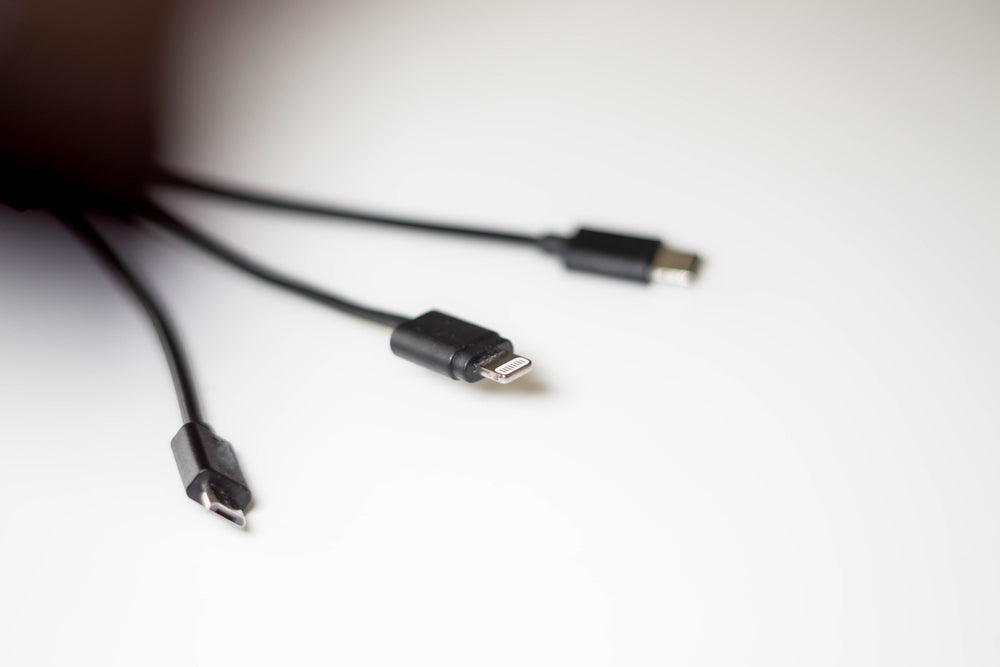There are a few cables on the market that you could purchase to charge your device. If you have a newer Android, and some Apple devices, then you should already be familiar with the USB-C cable which replaced the micro USB-A or USB-C cables. If you have any of Apple's iPhone models, then you should be using a lightning cable.
Which cable you use to charge your phone or device will depend entirely on the phone or device model you have; a lightning cable for iPhones and a USB-C cable for Android and some of the latest Apple products, including the MacBook Pro.
What is the Difference between a Lightning Cable and a USB-C Cable?
Other than the fact that lightning cables are exclusive to Apple and USB-C or Type-C cables are become increasingly popular across all manufacturers, both cables are used for charging and data transfer but they do have some differences in terms of compatibility, charging speed, and even physical features.
The lightning cables from Apple are designed with a small connector that fits perfectly into the charging port of an iPhone, iPad, or iPod. They are also used to transfer data between the device and a computer for storing data, uploading images and freeing up storage. In recent years, Apple has introduced USB-C cables for its latest products, such as the MacBook Pro. Although the lightning cable is exclusive to Apple, they just don't cut it when it comes to speed and efficiency. USB-C cables are now becoming more versatile and widely used among Apple users with the hopes of replacing lightning cables, especially in Europe.
On the other hand Android users typically use USB-C cables for more recent products. They are becoming increasingly popular as they provide faster charging speeds and more efficient data transfer than the older micro-USB cables. USB-C cables are designed with a symmetrical connector that can be plugged in either way, making them more convenient to use than the older cables which had to be plugged in a specific way.
It's important to note that not all USB-C cables are created equal. Some cables may not be compatible with certain devices, or may not be capable of delivering the same fast charging speeds as others. When shopping for a USB-C cable, look for cables that are labeled as "fast charging" or "quick charging (QC)" to ensure that they can provide the optimal charging speeds for your device.
Overall, the type of charging cable you need will depend on the specific device you own. It's important to check your device's manual or specifications to determine which type of cable is best suited for your device, and to choose a high-quality cable that is durable, fast-charging, and compatible with your device.
What to look for when choosing a charging cable
Compatibility
Lightning cables are proprietary cables developed by Apple and used exclusively with Apple devices such as iPhones, iPads, and iPods. USB-C cables, on the other hand, are becoming more popular as a universal charging and data transfer cable that is used by many devices including Android smartphones, tablets, laptops, and some newer Apple products.
Charging Speed
One of the main differences between the cables is the ability to fast charge your device. We found that USB-C cables typically offer faster charging speeds than Lightning cables that can deliver more power, up to 100 watts, compared to Lightning cables which typically deliver up to 12 watts of power. Quite a difference, especially if you’re on-the-go and need your phone charged quickly!
Physical Features
When it comes to the physical aspects of these two cables, Lightning cables have a thinner and smaller connector compared to USB-C cables. This makes them a little less study and easier to fall apart. The Lightning connector has eight pins and is designed to be reversible, meaning it can be inserted into a device in either direction. USB-C connectors are slightly larger and have 24 pins which are also reversible.
Data Transfer
One of the most important factors when deciding a cable is its ability to transfer data effectively. Both cables are capable of transferring data from a handheld device to a laptop, but USB-C cables offer faster data transfer rates than Lightning cables. In fact, USB-C cables can transfer data at up to 10 Gbps, while Lightning cables can transfer data at up to 480 Mbps.
While both Lightning and USB-C cables are used for charging and data transfer, they differ in terms of compatibility, charging speed, physical features, and data transfer rates. When it comes to using the right cable, you won’t be afforded choice as it is determined completely by the product manufacturer of your device. You do, however, have control over where you purchase them from. You don’t need to go directly to the source to grab a cable as there are a few renowned suppliers that sell these cables. The only thing we recommend is that you do your research and buy your charging cable from a reliable company as not all cables are made equally.
Check out the NEOFIER charging cables for your device.
